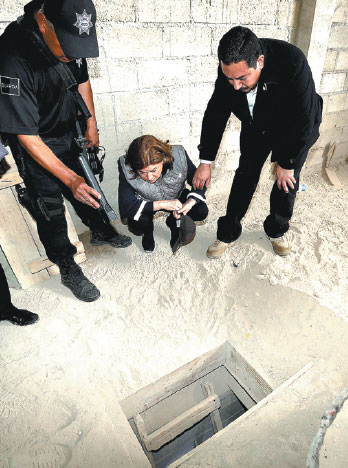Police hunt for drug kingpin
|
Mexican Attorney General Arely Gomez Gonzalez (second from right) looks into the entrance of a tunnel connected to the Altiplano Federal Penitentiary and used by drug lord Joaquin "El Chapo" Guzman to escape, in Almoloya de Juarez, on the outskirts of Mexico City, on Sunday. Attorney General's Office Via Reuters |
Sinaloa cartel leader's second prison break 'an affront to the state'
Mexican security forces hunted early Monday for drug kingpin Joaquin "El Chapo" Guzman as authorities investigated whether he had received inside help to escape prison through a tunnel under his cell's shower.
It was the second time in 14 years that Guzman, the head of the powerful Sinaloa drug cartel, managed to flee a maximum-security prison, dealing an embarrassing setback to President Enrique Pena Nieto.
Troops and police were deployed to find Guzman after he vanished late Saturday from the Altiplano prison, about 90 km west of Mexico City, after just 17 months behind bars.
Prosecutors questioned about 30 prison employees of various ranks, including the warden, the attorney general's office said, signaling suspicions of a possible inside job.
On a state visit to Paris, Pena Nieto said Guzman's escape was "an affront to the state" and demanded an investigation into whether prison guards helped him.
Guzman was able to slip out even though surveillance cameras were trained on his cell. After he never returned from the shower, guards found a hole 10 meters deep with a ladder in it, officials said.
The gap led to a 1.5-km-long tunnel with a ventilation and light system that was apparently dug with the help of a motorcycle mounted on a rail to transport tools and remove earth.
The tunnel led to a gray brick building on a hill surrounded by pastures in central Mexico State.
Prosecutors released a video showing the hole inside the building's dirt-covered floor. A bed and kitchen were in the facility, indicating that people may have lived there.
As investigators tried to figure out how Guzman fled again, police and troops manned checkpoints and searched cars and trucks on nearby roads.
"If he's not captured in the next 48 hours, he will have completely regained control of the Sinaloa cartel," said Mike Vigil, a retired US Drug Enforcement Administration international operations chief.
"If he is able to make his way to Sinaloa, his native state, and gets into that mountainous range, it's going to be very difficult to capture him because he enjoys the protection of local villagers."
Several states, including Sinaloa, set up checkpoints on roads. Central Puebla state said it was using X-ray technology at toll booths to see through cars.
Troops in Guatemala launched a special operation at the border with Mexico. It was in that country that Guzman was first arrested in 1993.
Guzman's first escape was in 2001, when he slipped past authorities by hiding in a laundry cart in western Jalisco state.
Marines had recaptured him in February 2014 in a predawn raid in a condo in Mazatlan, a Pacific resort in Sinaloa state, with the DEA's help.
AFP - AP



















